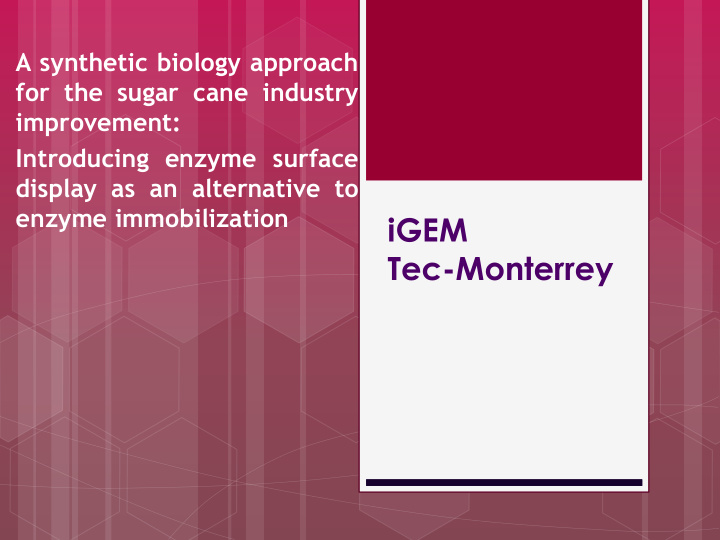



A synthetic biology approach for the sugar cane industry improvement: Introducing enzyme surface display as an alternative to enzyme immobilization iGEM Tec-Monterrey
Brainstorm Last year’s Biosensor Sulfurafane Metabolic pathway Curing Cancer
Different Approach Feasable Project Social and Economical Impact Versatile
Mexican Sugar Cane Industry 13.5% National agricultural production 5.3 million tons of sugar 4.8 million annual tons
57 sugar mills near 277 cities inhabited by 12 million people 450,000 direct jobs Benefits 2.2 million
Actual context Replacement of sugar by sweeteners like high fructose corn syrup. Industry of beverages NAFTA 2008 (North American Free Trade Agreement) Total cost of sugar production takes 80% of its sales.
Opportunities 2011 Past Imported sucrose sucrose fructose bagasse bagasse CO 2 11 million tons emission (51.8% cellulose)
Sugar Cane Industry Advances Novel Process: Sugar Cane Juice- Fructose
However there is still room left for optimization… Enzyme Overproduction Enzyme Purification Enzyme Immobilization
Analysis Economical Impact Social Impact Poor handling of byproducts Expensive downstream processing, specifically purification and immobilization of enzyme
How can we help? If we can provide a synthetic biology approach, to improve the sugar cane industry, then it will gain an added value by manufacturing valuable products High Fructose Syroup out of Sucrose Biofuels substrates out of bagaze (cellulose)
Main Objective Provide as a proof of concept, a genetic construction in a model microorganism ( Escherichia coli ), capable of displaying functional enzymes (invertase and cellulase) outside the cell.
Specific Objectives 1- Selection of a Capable Membrane Proteins 2- Selection of suitable Enzymes 3- Selection of appropriate strains 4- Design of a functional expression cassette 5-Evaluation of the expression of the constructs 6- Messurement of the chimeric enzymes activity
Membrane Proteins PhoA SP + EstA Fusion Lpp SP + OmpA Fusion 1-Extracellular Origin- Pseudomonas aeruginosa Origin- Escherichia coli Transport Ability Excression Mechanism: Type V Compatibility- Free N- Terminus 2-Signal Peptide PhoA SP- Alkalyne Phosphatase Excression mechanism: Type II Compatibility- Free C-terminus 3-Compatibility Lpp SP- Native Lipoprotein Linker + EstA Membrane Protein
1-Structure Extracellular Cellulase 2-Characteristics 3-Active Site SacC Invertase Origin- Zymmomonas mobilis Structure- Monomeric Structure Characteristics- 20°-40° C, pH 2.5-7.5, 48 kDa Free N-Terminus Extracellular RBS+signal peptide Sucrase phoA+Cellulase CelD Cellulase Origin- Clostridium thermocellum Structure- Monomeric Characteristics- Max 80° C, pH 5-8, 68 kDa Free C-Termius
Protein Expression Systems Rosetta Gami BL21 SI BL21 Star XL1Blue C43 E. coli Strains Characterization AraBAD BW27783
Expression Cassette Design Arabinose Induced Constructs
Construct Expression
CelD Expression Results o Expected MW fusion protein (estA + celD) 102.5 kDa
Device Functionality
CelD + estA Activity Rosetta Gami REDUCING DNS SUGARS y = 0.3085x - 0.0641 Calibration Curve R² = 0.982 0.5 Absorbance @540.0 nm 0.4 0.3 0.2 0.1 0 Proportional 0 0.5 1 1.5 2 Colorimetric Concentration of Glucose(mM) Concentration
Whole-Cell Rosetta Gami Soluble Cell Lysate Fraction Insoluble
Whole-Cell Cellulase Activity 400 Glucose Concentration (uM) 350 300 250 200 150 100 50 0 C- celD+estA Whole-Cell Cellulase Activity was determined by IUPAC Filter Paper Assay, with E. coli strain, Rosetta Gami, negative control and transformed T-test Alpha = 0.05 Suggesting Ho -> rejected
Cellulase Activity of Cell lysates INSOLUBLE FRACTION SOLUBLE FRACTION 400 400 Glucose Concentration (u M) Glucose Concentration (u M) 350 350 300 300 250 250 200 200 150 150 100 100 50 50 0 0 C- celD+estA C- celD+estA Cell Lysate Fractions Activity was determined by IUPAC Filter Paper Assay, with E. coli strain, Rosetta Gami cellular lysate, negative control and transformed with celD+estA T-test Alpha = 0.05 Ho -> rejected
We can conclude that … Difference between negative control and estA+celD -> Statiscally significant Cellulase + estA …. ACTIVE Activity in C- …. Background signal
Future Work • Standarize the IUPAC Filter Paper Assay -> more measurements • LB media -> M9 media or others • Different E. coli strains • Another measurement methods e.g . Benedict method , HPLC
Construct Expression
SacC Expression Results Expected MW fusion protein (OmpA + SacC) 62.8 kDa Unclear evidence vector expression by SDS-PAGE + Coomassie blue
Device Functionality
Whole Cell SacC Activity Enzyme assay BL21 SI Enzymatic reaction using sucrose as substrate @ pH 5.0, @ 36°C 30 min Quantification of released fructose Colorimetric assay based on Tetrazole reduction
BL21SI Tetrazole ---- Fructose t-Test (2 tails, α =0.05) Rejects the null hypothesys H 0 = The population means are the same
Conclusion • More Specific Stain • More measurements • Different E. coli strains • Another measurement methods e.g . HPLC
Human Practice Genes in a Bottle Molecular biology workshop Ene.Pé notes Myths and facts Biotech MicroCongress
Augmented Biobricks Synthetic biology Real time 3D modeling of your construct
Further Approach Comparing Raw Data with analytic tests Eukaryotic systems for heterologous expression Sustainable high fructose syrup process Unit operaations
Thank you.
Recommend
More recommend